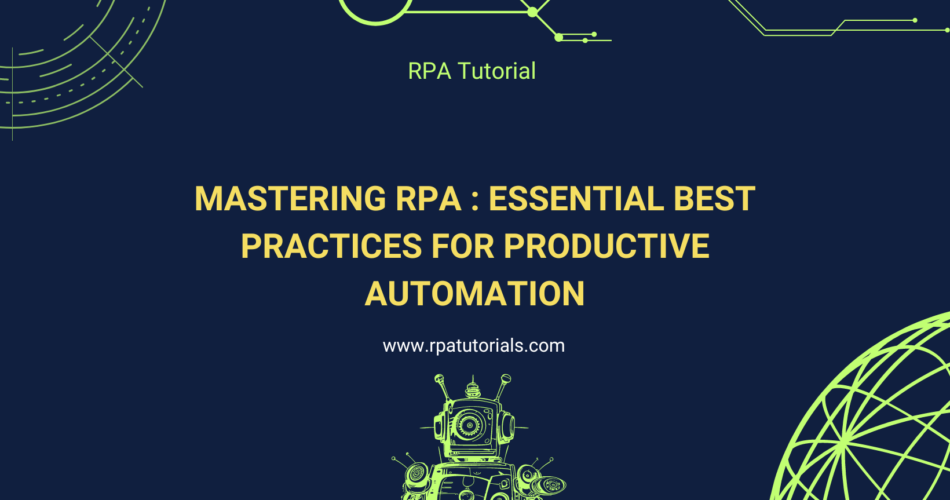Overview
Mastering RPA can significantly boost productivity and streamline business processes. However, to fully reap the benefits, it’s essential to adhere to key RPA Best Practices during development and deployment. In this guide, I’ll outline essential advice to help you implement RPA Best Practices for creating reliable, efficient, and maintainable automation solutions.
Table of Contents
- Understanding the Process
- Designing Robust Workflows
- Implementing Error Handling and Logging
- Optimizing Performance
- Ensuring Security and Compliance
- Testing and Maintenance
1. Understanding the Process
Conduct Thorough Process Analysis:
Before diving into automation, it’s crucial to fully understand the process you’re automating. Following RPA Best Practices, identify key steps, exceptions, and potential pitfalls.
Engage Stakeholders:
Collaborate with process owners and stakeholders to ensure alignment with business objectives. This RPA Best Practice ensures the automation meets everyone’s needs.
Document the Process:
Create detailed documentation, such as flowcharts and step-by-step instructions. Following RPA Best Practices, will serve as a roadmap throughout the development lifecycle.
2. Designing Robust Workflows
Modular Design:
Break automation into smaller, reusable components. This RPA Best Practice makes workflows more manageable and easier to maintain.
Use Descriptive Names:
Name your activities, variables, and arguments clearly. This RPA Best Practice enhances readability and helps others understand the workflow quickly.
Implement Proper Flow Control:
Utilize sequences, flowcharts, and state machines appropriately to manage the automation flow efficiently, a core part of RPA Best Practices.
3. Implementing Error Handling and Logging
Robust Error Handling:
Implement try-catch blocks to gracefully manage exceptions. Define retry mechanisms, a crucial element of RPA Best Practices, to ensure reliability.
Comprehensive Logging:
Use logging activities to capture key information at various stages. This RPA Best Practice helps with debugging and offers a valuable audit trail.
Alert Mechanisms:
Set up alerts for critical failures. This RPA Best Practice ensures proactive management and avoids unnecessary downtime.
4. Optimizing Performance
Efficient Data Handling:
Minimize data processing within loops and optimize data structures, an essential RPA Best Practice, to keep the automation running smoothly.
Parallel Processing:
Utilize parallel processing activities to execute independent tasks simultaneously. This RPA Best Practice can significantly boost performance.
Resource Management:
Monitor resource usage and optimize activities to avoid memory leaks, a key component of RPA Best Practices.
5. Ensuring Security and Compliance
Secure Credential Management:
Store credentials securely using tools like UiPath Orchestrator assets or Windows Credential Manager. Security is a critical aspect of RPA Best Practices.
Data Privacy:
Ensure compliance with data privacy regulations by properly handling sensitive data, a mandatory RPA Best Practice.
Access Control:
Implement role-based access control to safeguard the automation environment, another key element of RPA Best Practices.
6. Testing and Maintenance
Comprehensive Testing:
Conduct thorough testing, including unit, integration, and user acceptance tests. This RPA Best Practice ensures the automation functions as expected.
Regular Maintenance:
Schedule regular maintenance to update automation scripts and manage dependencies. Following this RPA Best Practice helps adapt to process changes over time.
Continuous Improvement:
Collect feedback and monitor automation performance. This RPA Best Practice is vital for identifying areas for further optimization.
Conclusion
Adhering to these RPA Best Practices ensures that your automation projects are robust, efficient, and maintainable. From understanding the process to optimizing performance and ensuring security, following these guidelines will maximize the benefits of RPA and drive significant improvements in your organization’s productivity and efficiency.
Stick to these RPA Best Practices to ensure long-term success and impactful automation projects. Happy automating!
